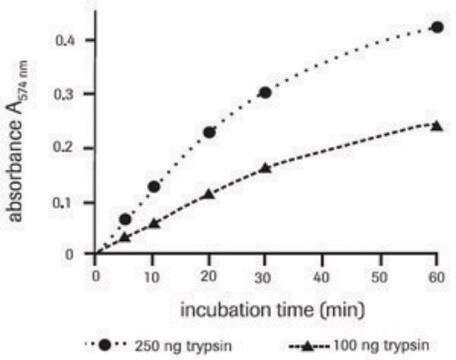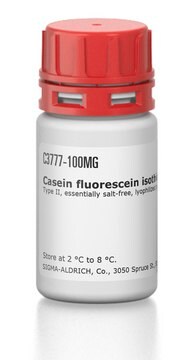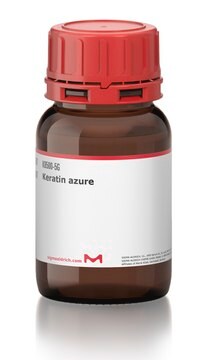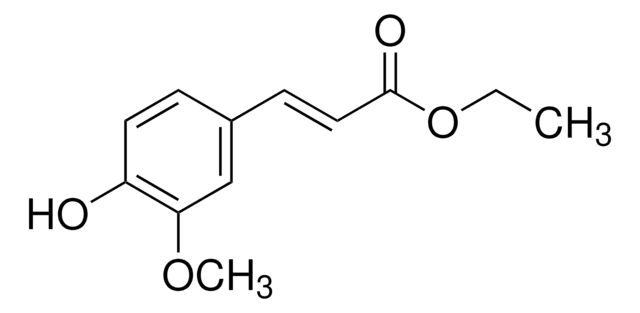추천 제품
제품명
Azocasein, protease substrate
생물학적 소스
bovine
Quality Level
양식
powder
기술
ligand binding assay: suitable
solubility
water: 5 mg/mL, clear, orange to very deep orange
ε (흡광계수)
≥25 at 440 nm in 0.1 M NaOH at 1%
저장 온도
2-8°C
일반 설명
Azocasein is a chromogenic derivative of casein. Protease degrades azocasein to yield TCA-soluble azopeptides with high UV-absorbance. This azocasein assay is widely employed to estimate the protease production by bacterial fermentation on synthetic substrates from glucose and inorganic salts.
애플리케이션
Azocasein has been used as a substrate for determination of protease activity.
Azocasein is a nonspecific protease substrate. Hydrolysis of the casein releases the azo dye into the media where it is detected by absorbance at 440 nm.
Azocasein is an inflammatory agent that is used to induce amyloid A amylooidosis in experimental animals.
결합
View more information on azocasein protease assay at www.sigma-aldrich.com/enzymeexplorer
Storage Class Code
11 - Combustible Solids
WGK
WGK 3
Flash Point (°F)
Not applicable
Flash Point (°C)
Not applicable
개인 보호 장비
Eyeshields, Gloves, type N95 (US)
가장 최신 버전 중 하나를 선택하세요:
시험 성적서(COA)
Lot/Batch Number
이미 열람한 고객
Alejandro L Antonia et al.
PLoS neglected tropical diseases, 15(10), e0009224-e0009224 (2021-10-29)
Leishmaniasis is a neglected tropical disease with diverse outcomes ranging from self-healing lesions, to progressive non-healing lesions, to metastatic spread and destruction of mucous membranes. Although resolution of cutaneous leishmaniasis is a classic example of type-1 immunity leading to self-healing
Yosuke Tashiro et al.
Journal of bacteriology, 191(24), 7509-7519 (2009-10-20)
The opportunistic human bacterial pathogen Pseudomonas aeruginosa produces membrane vesicles (MVs) in its surrounding environment. Several features of the P. aeruginosa MV production mechanism are still unknown. We previously observed that depletion of Opr86, which has a role in outer
Isabel Morales-Belpaire et al.
Water research, 42(17), 4449-4456 (2008-09-03)
Laboratory data on the behaviour of the pathogenic form of the prion protein (PrP(Sc)) in environmental matrices such as sewage sludge is scarce. Direct experiments with this misfolded protein require strict safety measures, pathogen class-3 facilities and costly reagents. However
Isolation and characterization of chitinolytic Streptomyces sp. MT7 and its antagonism towards wood-rotting fungi
Nagpure, A, et al.
Annals of Microbiology, 64(2), 531-541 (2014)
Azocasein assay for alkaline protease in complex fermentation broth
Iversen SL and Jorgensen MH
Biotechnol. Tech., 9(8), 573-576 (1995)
자사의 과학자팀은 생명 과학, 재료 과학, 화학 합성, 크로마토그래피, 분석 및 기타 많은 영역을 포함한 모든 과학 분야에 경험이 있습니다..
고객지원팀으로 연락바랍니다.









